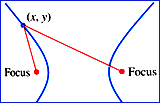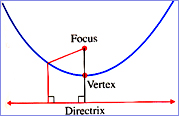"The Great Geometer"
The
birthday of Apollonius is not known. The NCB has chosen to honor
him on September 22 or 23, the day of the autumnal equinox, one of two
annual dates when day and night are the same length.
Apollonius named the Conic Sections - the parabola, ellipse, and hyperbola. Moreover, he chose the ancient Greek names of "ellipse" and "hyperbola" for their meaning in relationship to the "parabola."
 Though formulated in the 3rd century B.C.,
these curves along with the
circle, are probably the most studied around the world. Only the
sine and cosine, along with exponential and logarithmic functions are
any competition.
Though formulated in the 3rd century B.C.,
these curves along with the
circle, are probably the most studied around the world. Only the
sine and cosine, along with exponential and logarithmic functions are
any competition.
Interestingly, the corresponding literary terms are parable, ellipsis, and hyperbole.
Apollonius named the Conic Sections - the parabola, ellipse, and hyperbola. Moreover, he chose the ancient Greek names of "ellipse" and "hyperbola" for their meaning in relationship to the "parabola."
For
a parabola, any point on the curve is equidistant to both the focus  and its
directrix. He chose "ellipse" for its meaning of "falling
short." Certainly we recognize one axis of an ellipse is always
shorter than the other. Continuing his pattern, "hyperbola" was
chosen for its meaning of "throwing beyond" where the distance
from any point on the curve to one focus is always greater than the
distance to its second focus.
and its
directrix. He chose "ellipse" for its meaning of "falling
short." Certainly we recognize one axis of an ellipse is always
shorter than the other. Continuing his pattern, "hyperbola" was
chosen for its meaning of "throwing beyond" where the distance
from any point on the curve to one focus is always greater than the
distance to its second focus.
 and its
directrix. He chose "ellipse" for its meaning of "falling
short." Certainly we recognize one axis of an ellipse is always
shorter than the other. Continuing his pattern, "hyperbola" was
chosen for its meaning of "throwing beyond" where the distance
from any point on the curve to one focus is always greater than the
distance to its second focus.
and its
directrix. He chose "ellipse" for its meaning of "falling
short." Certainly we recognize one axis of an ellipse is always
shorter than the other. Continuing his pattern, "hyperbola" was
chosen for its meaning of "throwing beyond" where the distance
from any point on the curve to one focus is always greater than the
distance to its second focus. Though formulated in the 3rd century B.C.,
these curves along with the
circle, are probably the most studied around the world. Only the
sine and cosine, along with exponential and logarithmic functions are
any competition.
Though formulated in the 3rd century B.C.,
these curves along with the
circle, are probably the most studied around the world. Only the
sine and cosine, along with exponential and logarithmic functions are
any competition.Interestingly, the corresponding literary terms are parable, ellipsis, and hyperbole.